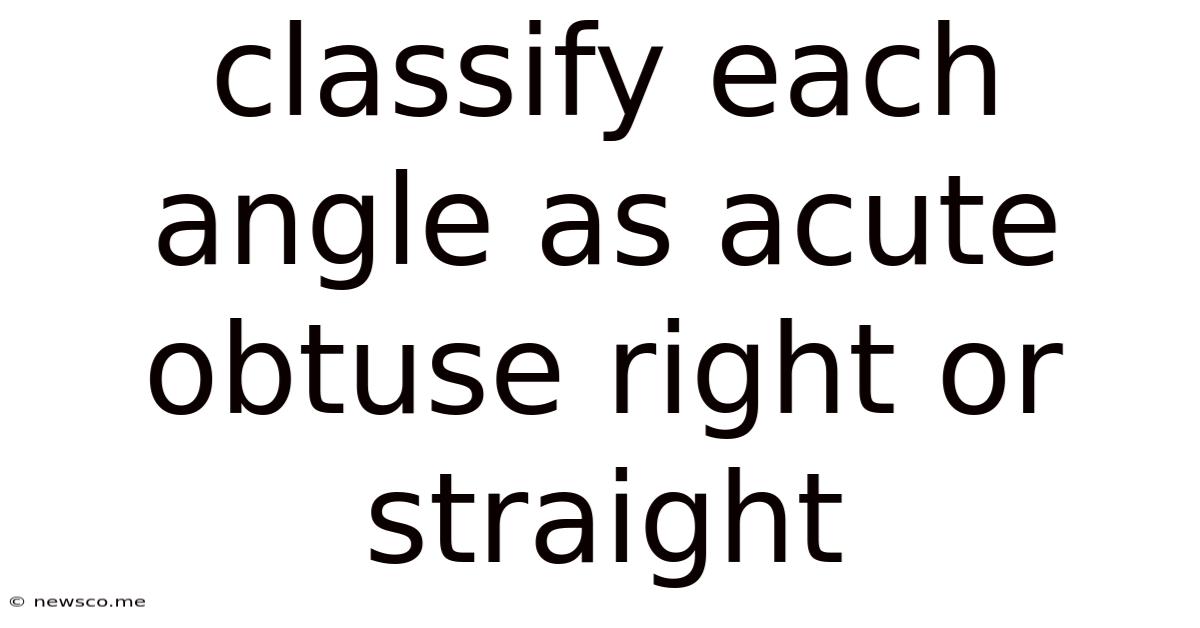Classify Each Angle As Acute Obtuse Right Or Straight
News Co
May 07, 2025 · 5 min read

Table of Contents
Classify Each Angle as Acute, Obtuse, Right, or Straight: A Comprehensive Guide
Understanding angles is fundamental to geometry and numerous applications in the real world. This comprehensive guide will delve into the classification of angles—acute, obtuse, right, and straight—providing clear definitions, illustrative examples, and practical applications. We'll explore how to identify each type of angle, differentiate between them, and solidify your understanding with real-world scenarios.
Understanding Angle Measurement
Before classifying angles, it's crucial to understand how angles are measured. Angles are formed by two rays sharing a common endpoint, called the vertex. The measure of an angle is the amount of rotation between these two rays. We typically measure angles in degrees (°). A full rotation around a point is 360°.
Key Angle Types:
-
Acute Angle: An acute angle is an angle whose measure is greater than 0° but less than 90°. Think of it as a "sharp" angle. Imagine a slice of pizza—a small slice forms an acute angle.
-
Right Angle: A right angle is an angle whose measure is exactly 90°. It's often represented by a small square drawn in the corner of the angle. The corner of a perfectly square piece of paper forms a right angle. Right angles are fundamental in construction and design.
-
Obtuse Angle: An obtuse angle is an angle whose measure is greater than 90° but less than 180°. It's a "wide" angle, larger than a right angle. Think of the angle formed by opening a door more than halfway.
-
Straight Angle: A straight angle is an angle whose measure is exactly 180°. It forms a straight line. If you extend the two rays of a right angle until they meet on the opposite sides, it forms a straight angle.
Identifying Angle Types: A Practical Approach
Let's explore practical methods for identifying different angle types. The key is to visualize the angle and compare its measure to the benchmark angles (90° and 180°).
Visual Inspection:
The simplest method is visual inspection. By looking at the angle, you can often make a reasonable estimate of its type. Acute angles appear sharp, right angles form a perfect "corner", obtuse angles are wider than a right angle, and straight angles form a straight line.
However, visual inspection is not always precise. For accurate classification, you need to measure the angle using a protractor.
Using a Protractor:
A protractor is a tool specifically designed to measure angles. To use a protractor:
- Align the protractor's base with one ray of the angle.
- Place the protractor's center point on the vertex of the angle.
- Read the degree measure where the second ray intersects the protractor's scale.
This will give you the precise measure of the angle, allowing for accurate classification.
Real-World Applications of Angle Classification:
The classification of angles has numerous applications across various fields. Let's explore a few examples:
Architecture and Construction:
- Right angles: Essential for building stable structures. Walls, floors, and ceilings must meet at right angles to ensure structural integrity.
- Acute and obtuse angles: Used in designing aesthetically pleasing and functional buildings. The angles of roofs, windows, and other architectural features are carefully chosen to optimize both appearance and structural stability.
Engineering:
- Right angles: Crucial in mechanical engineering for designing gears, pulleys, and other mechanical components.
- Acute and obtuse angles: Used in designing ramps, slopes, and other angled surfaces.
Computer Graphics and Design:
- All angle types: Fundamental in creating shapes, images, and animations. Precise angle measurements are crucial for creating accurate and aesthetically pleasing visuals.
Navigation:
- Acute and obtuse angles: Used to determine bearings and directions. Navigational systems rely on accurate angle calculations to plot courses and determine locations.
Physics:
- All angle types: Essential in analyzing forces, vectors, and motion. The angles between forces determine the resultant force.
Advanced Concepts and Challenges:
While classifying simple angles is straightforward, certain situations can present challenges:
Combining Angles:
Sometimes, angles are formed by combining smaller angles. In such cases, you need to add the measures of the smaller angles to determine the overall angle type.
Angles in Three Dimensions:
Classifying angles in three dimensions can be more complex. You might need to use additional techniques like vector analysis to determine the angles accurately.
Angles and Triangles:
Triangles are polygons with three sides and three angles. The sum of the interior angles of any triangle is always 180°. This property is crucial in determining the type of triangle based on its angles (e.g., acute, obtuse, or right triangle).
Practicing Angle Classification:
The best way to master angle classification is through practice. Try these exercises:
- Draw various angles and attempt to classify them visually.
- Use a protractor to measure the angles and verify your classifications.
- Look for angles in your surroundings and try to classify them (e.g., angles in furniture, buildings, or everyday objects).
- Solve geometry problems that involve angle classification and calculations.
By consistently practicing these exercises, you'll develop a strong understanding of angle classification and its real-world applications.
Conclusion:
Classifying angles as acute, obtuse, right, or straight is a fundamental concept in geometry with wide-ranging applications. Understanding the definitions and using tools like protractors allows for accurate identification, contributing significantly to various fields like architecture, engineering, and computer graphics. Through consistent practice and exploring real-world examples, you can effectively master this crucial geometric concept. This thorough understanding lays the groundwork for further exploration in more advanced geometrical concepts and problem-solving. Remember, the key to mastering angle classification lies in consistent practice and careful observation.
Latest Posts
Related Post
Thank you for visiting our website which covers about Classify Each Angle As Acute Obtuse Right Or Straight . We hope the information provided has been useful to you. Feel free to contact us if you have any questions or need further assistance. See you next time and don't miss to bookmark.